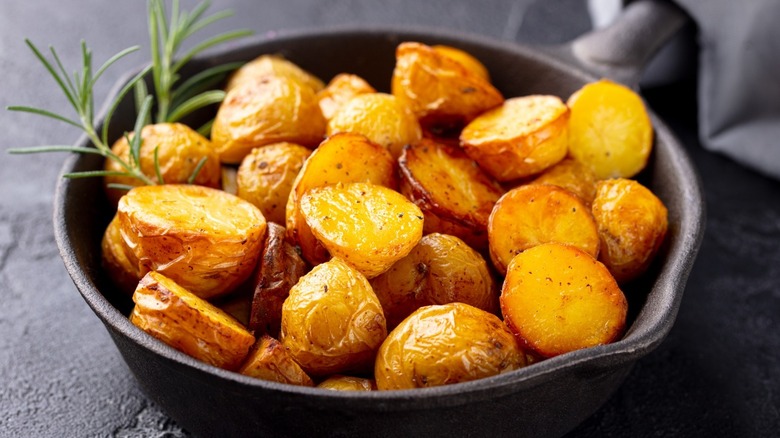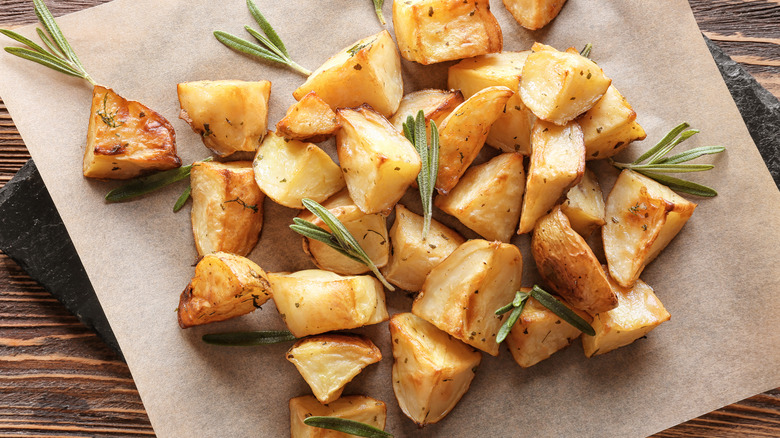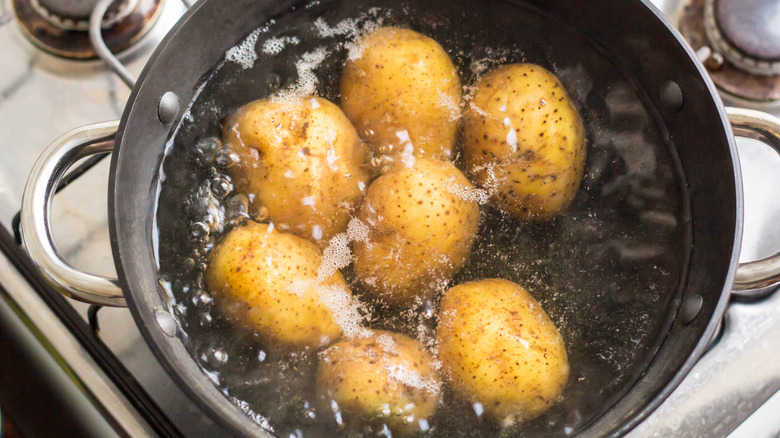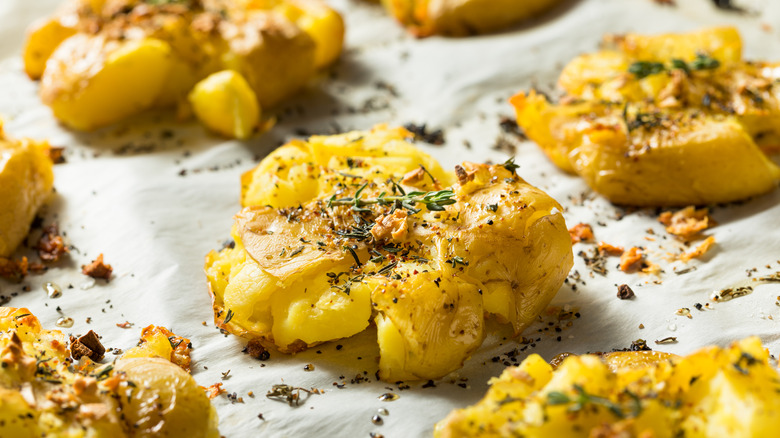Don't Skip These Steps When Roasting Potatoes
When you think of roasted potatoes, what comes to mind? Is it a pan full of crispy, golden-brown potatoes with a soft, tender interior? Or perhaps you envision wet, barely cooked potatoes that are one part overdone and one part half-baked? Roasted potatoes can be a delicious and oil-free alternative to French fries — or something that makes you wish you had a plate of fries in front of you instead of whatever starchy mess you're eating.
Fortunately, there are plenty of ways you can experiment with this dish — potatoes are a versatile vegetable, after all. You could follow Jamie Oliver's roast potatoes recipe with a twist or you could try Ree Drummond's recipe for parmesan roasted potatoes (via Food Network). There's even a trick Ina Garten has for perfect roasted potatoes you might like. Whether you like your potatoes drenched in garlic and cheese or just served with salt and pepper, one thing most people want from this dish is crispiness. If it's not a lightly crunchy exterior with an interior reminiscent of French fries and mashed potatoes — it's not satisfactory.
But how can you avoid the pitfalls of the undone roasted potato? How can you ensure that they come out perfect every time? All you may need to do is focus on the pan that you're dumping your potato chunks in.
Preheat the pan before you add the potatoes
If you want your food to be crispy, you probably think of this complex culinary formula — "more heat equals more crisp." After all, the hotter the area your food is exposed to, the crisper it will become, right? But if your potatoes are in the oven already and they're still not coming out crispy, what could be wrong?
The answer, RealSimple explains, is that you should be "pre-heating" your pan beforehand to the desired temperature you're going to be roasting your potatoes. While the outlet suggests leaving your pan in the oven for 10 minutes, they also note that this is a "forgivable" process, so you can leave your pan until you feel it's hot enough. By heating the surface of the pan, the potatoes will start to bake as soon as they touch the surface, rather than having to cook after a few minutes in the oven. This results in the potatoes getting that golden-brown color faster.
Serious Eats suggests a more complex way of producing crispy roasted potatoes that is British in origin. It involves first boiling the potatoes, tossing them in a fat, such as goose or duck fat, and then roasting them for a crisp, solid exterior and a fluffy, moist interior. This is recommended for those who have more time on their hands as compared to the quicker process offered by RealSimple.
Try parboiling before you roast
Just in case you've never heard of parboiling before, Food Fanatic defines it as a cooking method where you're "partially boiling an ingredient." You're boiling your food — in this case, potatoes — but not all the way through. "But I'm roasting my potatoes, not making mashed potatoes," you may be saying. "Why do I have to boil my potatoes if I'm roasting them?" That's a fair point. You don't have to parboil your potatoes if you're in a hurry, and there's no reason to say they wouldn't turn out fine. However, parboiling does offer an important benefit: ensuring a soft, creamy interior while still keeping that crispy skin.
As Cook'n explains, parboiling your potato chunks involves placing your potatoes in a pot of cold water and turning up the stove to high heat until the water starts to boil. Reduce the heat, and then boil the potatoes between 5 to 10 minutes or until a fork can pass through the potatoes with some resistance. Remember, it's important that they are not cooked all the way through. From there, simply drain the potatoes, give them a few minutes to cool, and roast them as you usually would.
But how does this help your potatoes? Kitchen Seer tells us that the parboiling process helps the potatoes roast faster, allowing them to crisp quickly and more evenly than they would without this step. If you boil them all the way through, you may run the risk of getting mushy insides.
Smash your potatoes for a crispier result
When you make roasted potatoes, it's probably a safe bet to say you just leave them as they are in their pyramid-shaped chunks and roast them that way. While this is a tried-and-true method for making some pretty good potatoes, have you ever thought about "smashing" your potatoes first? If so, what does "smashing" entail?
MasterClass's roasted potato recipe seems to be standard, up until the part where it calls for you to "gently press" down on the potatoes with the bottom of a glass in order to "flatten" them. Why go through this extra step? According to Last Ingredient, "smashing" your potatoes gives them more surface area, which in turn exposes more of the potatoes to the heat of the pan. This means that, compared to your "unsmashed" potatoes, these smashed spuds will have crispier edges and skin while still remaining soft on the inside. It's important to note, however, that you don't want to smash them full-on like you're making mashed potatoes. Simply flatten them out a bit into a circular shape.
If you don't like the flattened look for presentation purposes, you could still make sure to get crispy edges on all sides by simply tossing your potatoes every few minutes. During the roasting process, this will ensure all parts of the potatoes are exposed to as much heat as possible.



